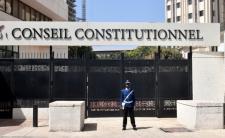Political system and history
Like most former French colonies, contemporary Senegal has a semi presidential system of government based primarily on the model of the fifth French Republic established in 1958. It obtained full independence from France in 1960 and was briefly part of the Mali Federation until the latter’s break up in August 1960. Leopold Sedar Senghor became its first elected President shortly thereafter following his victory in parliamentary elections same year. Following political rivalry between the heads of the two tier executive and a coup in 1962, the parliamentary system was abolished in favour of a presidential system with an executive president. Senghor remained president until 1981 when he hand picked Abdou Diouf to replace him. In 1982, Senegal joined the Gambia to form the short-lived Confederation of Senegambia. Diouf served four terms as President until his defeat by opposition leader, Abdoulaye Wade in the 2000 presidential elections.
Constitutional history and development
Senegalese constitutionalists have described its constitutional history and development as a meandering trail of both rich and complex experiences. This is seen quantitatively, in the number of constitutions and draft constitutions produced between 1959 and today.
Constitutional development during the period of decolonization
The Constitution of 1959 and the 1960 constitutional revision
This period is characterised by the drafting of two key constitutions – the very first being that of 1959 and the second, promulgated by law no 60/045 amending the 1959 constitution. Essentially, the 1959 Constitution was the basic law of the federated state of Senegal within the Mali Federation whereas the 1960 amendment was designed to reconfigure the state after the break up of the federation. This was techincally though, the independence constitution of Senegal. It created a parliamentary system for Senegal with a bicephalist executive.
Post independence constitutional development
The 1962 constitutional amendment
Post 1960 constitutional development was characterised by political rivalry between the two heads of the executive. The 1960 Constitution created a two tier executive structure with Senghor as president and Mamadou Dia as Prime Minister. Conflict of power between these two however resulted in a failed coup led by the Prime Minister in 1962. The consequence was a reconfiguration of the power structure in Senegal after the coup was crushed in December 1962. To avoid such conflicts of power, the parliamentary system was abolished in a constitutional amendment through law no 63/22, establishing a presidential system with strengthened executive powers. This constitution substantially remained in place - with mostly periodic amendments. In 1966, Senghor’s Union Progressive was declared the sole political party in the country and Senegal became a one party state. This was the position until a three-party political system was reintroduced in 1978.
Post cold war constitutional development
The 1991 constitutional amendments
Despite building and consolidating some degree of democratic governance between 1960 and the late 1980s, the winds of change that were blowing across Africa and pressuring the continents regimes to democratize- as well as recurrent post election unrests subsequently brought the issue of constitutional reform and concessions to the fore. In March 1991, the National Assembly approved several constitutional amendments. Key features of the reforms included the restoration of the position of Prime Minister - devised as a measure to dilute presidential powers. Opposition parties were also allowed to participate in government.
Amendments to the electoral code included a seven-year term of office for the president limited to a maximum of two mandates. The presidential elections would also take place in two rounds if necessary in which case the president have to be elected by at least one-quarter of registered voters and by an absolute majority of votes cast. Elections to the presidency would no longer coincide with legislative elections, which would continue to take place at five-yearly intervals. The voting age was also lowered from 21 to 18 years, while judicial reforms resulted in the abolition of the Supreme Court and its functions divided between three newly created bodies: A Constitutional Court, a Council of State and a Court of Higher Appeal. For the next 10 years though, political life in Senegal continued to be dominated by the ruling Partie Socialiste (PS) headed by Diouf.
Political and constitutional developments in 2000
Presidential elections in 2000 brought an unexpected end to the political hegemony of the Diouf-led PS. Abdoulaye Wade, a lawyer who had been in the opposition for over 20 years, campaigning on promises to rupture the ancien regime, led the Senegalese Democratic Party (SDP) to a win after a run off in the presidential elections of 2000. This change at the helm of state was welcomed by many reformists as a historic opportunity to establish a new political and social order, which would eclipse the existing presidentialist system in favour of a parliamentary regime. More precisely, reformists called for the abolition of the constitutional framework created in 1963 by Senghor and consolidated by Abdou Diouf for over two decades. Reformists advocated for a new order based on the social contract and principles of participation. This is the socio political context in which the constitutional reforms that eventually resulted in a new constitution in January 2001 can be understood.
The Constitutional referendum of 7 January, 2001
Following the cataclysmic changes to the Senegalese power structure brought by the March 2000 elections, the main challenge for the new political leaders was to quickly honour promises for institutional reforms made during the campaigns. The new political leadership was faced with two main options for reform: a moderate approach consisting of minor or major revisions to the existing constitution (1963) or, a more radical approach involving writing a new charter from scratch. The latter approach was favoured by the new presidential majority but was most likely to be rejected by the old regime which still had a parliamentary majority and unlikely to yield to reforms that negatively affected its political interest.
From a procedural perspective, the new regime was also walking on a very tight rope regardless of whether what was sought was a revision of the existing charter or the adoption of a new charter. Per article 89 of the constitution, the prerogative to initiate constitutional revision was split between parliament and the executive with the proposed amendment becoming final only after a referendum vote, or a positive vote in the two houses of parliament meeting in congress, where the president chose to submit the bill through such approval process. On the other hand, even if the new presidential majority chose to push for the adoption of a new charter, the context of democratic change in which this was happening would still require compromises with other constitutional institutions, particularly parliament. The three options in this scenario would have been either (1) parliament constitutes itself into a Constituent Assembly as was the case in 1959 to adopt new charter, or (2) it adopts a law amending the constitution as was the case in 1960, or, (3) it empowers the executive with full powers to initiate a new process that would result in a completely new charter. Lacking the parliamentary majority to facilitate his agenda, Wade found himself in a complex political impasse as either way; parliament had a central role to play in the process regardless of the procedure adopted.
Following intense negotiations and political compromises between the executive and the opposition controlled parliament, an agreement for a completely new charter was reached. With obvious public fatigue and disillusionment with more than two decades of presidentialism, the key issue at stake was what system of government to put in place and the extent to which reforms should be made to certain constitutional institutions like the senate, the national assembly and, the economic and social council?
A six man technical commission of experts headed by the Minister of Justice – comprising two constitutional law professors, a representative of the president of the republic, a representative of the government, a representative of the constitutional council and one jurist representing the civil society – was appointed by presidential decree No 00/372 of 19 May 2000 to drive the process. Its main functions were to prepare a draft constitution and calendar for referendum. The draft was to be submitted to the key actors – notably, an inter ministerial council headed by the Prime Minister, the Presidents of the Senate and the National Assembly and all the political parties - who would have fifteen days to make submissions and propose amendments. Based on these submissions, the commission was to produce a final draft and submit to the president who alone was constitutionally empowered to call a referendum.
Although what Wade and the PDS premised their campaign strategy on for the presidential elections of 2000 was regime change that would see the presidential regime eclipsed by parliamentary system compatible with long term stability to enable the implementation of their electoral promises, what emerged from the final draft was a compromise between elements of presidentialism and parliamentarism. Key points thereof was the curtailment and transfer of certain executive powers from the president to the prime minister, parliamentary control of government action through a censure vote without fear of dissolution (even though the president still had this power). This draft was the constitution that was finally adopted in the referendum of 7 January 2001. This is the current constitution of Senegal which has itself been subject to many amendments since its adoption.
Key timelines in the 2001 constitutional process:
| March 2000 | Abdoulaye Wade’s SDP defeats the PS of Abdou Diouf on a presidential election campaign platform to establish a new charter during the presidential elections. |
| April 2000 | The SDP consolidates its position through a majority win in the parliamentary elections. |
| 20 April 2000 | President Wade convenes a Council of Ministers Meeting to examine the procedure for initiating institutional reforms. |
| 2 May 2000 | Process for an exceptional review of electoral lists commences. |
| 19 May 2000 | A six man technical commission of experts is established by presidential decree to coordinate the process. |
| 9 November 2000 | The Constitutional Council hands down its advisory opinion on the final draft clearing the way for a constitutional referendum on the draft. |
| 7 January 2001 | Senegalese vote in a constitutional referendum to adopt the draft. |
| 22 January 2001 | The new constitution is promulgated into law. |
| Branch | Hierarchy | Powers | Removal |
|---|






Share this article